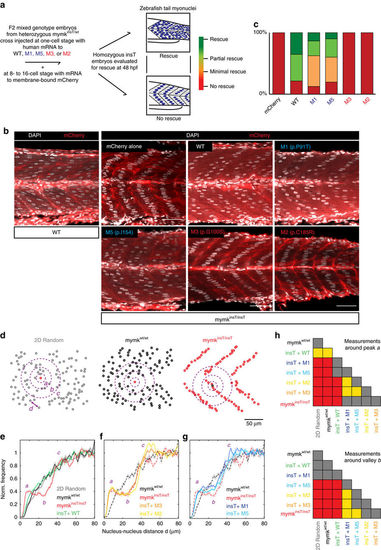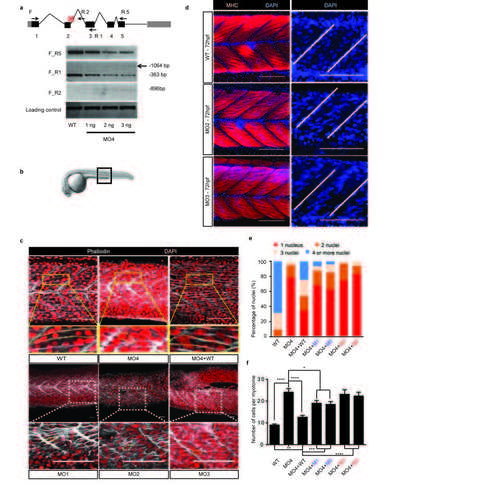- Title
-
A defect in myoblast fusion underlies Carey-Fineman-Ziter syndrome
- Authors
- Di Gioia, S.A., Connors, S., Matsunami, N., Cannavino, J., Rose, M.F., Gilette, N.M., Artoni, P., de Macena Sobreira, N.L., Chan, W.M., Webb, B.D., Robson, C.D., Cheng, L., Van Ryzin, C., Ramirez-Martinez, A., Mohassel, P., Leppert, M., Scholand, M.B., Grunseich, C., Ferreira, C.R., Hartman, T., Hayes, I.M., Morgan, T., Markie, D.M., Fagiolini, M., Swift, A., Chines, P.S., Speck-Martins, C.E., Collins, F.S., Jabs, E.W., Bönnemann, C.G., Olson, E.N., Carey, J.C., Robertson, S.P., Manoli, I., Engle, E.C.
- Source
- Full text @ Nat. Commun.
|
mymkinsT/insT zebrafish embryos lack fast-twitch myoblast fusion and adults have CFZS-like myopathic features. (a) 24 h.p.f. embryos stained with 488-conjugated phalloidin (white) and DAPI (red) to label the forming myofibers and nuclei, respectively. WT mymkwt/wt embryo myofibers are multinucleated, while mymkinsT/insT embryo myofibers elongate and differentiate, but fail to fuse. (b) Upper panel: 48 h.p.f. embryos stained with DAPI show the distribution of myonuclei in fused mymkwt/wt (left) and unfused (right) mymkinsT/insT fast-twitch myofibers. Compared to the random appearance of WT myonuclei, the single nuclei in unfused mymkinsT/insT myofibers pathologically align at the center, equidistant between two myosepta. Lower panel: Merged images showing phalloidin (red), DAPI (white) and F59 (green, anti-myosin heavy chain) confirm that affected myofibers are fast-twitch fibers because they do not express F59, a slow-twitch cellular marker in zebrafish. (c) A 6-month-old male mymkwt/wt zebrafish (top) compared to an age- and sex-matched tmem8cinsT/insT fish (bottom). Male and female mutant zebrafish are small and have a flattened/retrognathic jaw (right, indicated by dotted line and black arrowhead) not appreciated during larval and early juvenile stages. By 3 months of age, jaw weakness prohibits mymkinsT/insT zebrafish from fully closing their mouths. (d,e) Adult mymkinsT/insT zebrafish (n=3) are significantly shorter (d) and weigh less (e) than age and sex-matched WT siblings (n=7). (f) Hematoxylin-Eosin (H&E) staining of caudal transverse sections of WT (top) and mymkisnT/insT (bottom) of 6-month-old male zebrafish siblings at three magnifications. Zebrafish mymk-expressing fast-twitch myofibers are located centrally, while mymk-negative slow-twitch myofibers are located near the body wall and stain slightly darker with H&E. The mutant fish have reduced body width (compare the red line extending from the dorsal artery to the body wall in WT versus mutant fish in left photos), and fat infiltration (thick black arrows, middle photo) that is absent in the WT fish. Fast-twitch myofibers appear smaller compared to WT (right). Statistics by two-tailed Student’s unpaired t-test; mean±s.e.m.; **P<0.002. Scale bars, (a,b) main images 50 μm, insets 10 μm. (f) left and center panels 500 μm, right panels 50 μm. See also Supplementary Figs 6,7 and Supplementary Video. |
|
Ectopic expression of MYMK-WT and -hypomorphic alleles can fully or partially rescue the mymkinsT/insT fusion phenotype. (a) Approach to evaluate rescue of mymkinsT/insT 48 h.p.f. embryo fusion phenotype following co-injection of WT or mutant human MYMK mRNA. Nuclear dispersion is qualitatively stated to be low (no rescue), minimal (slight rescue), moderate (partial rescue), or high (rescue). (b) Optical sections of laterally mounted 48 hpf mymkwt/wt embryo injected with mCherry, and six mymkinsT/insT embryos injected as per a. WT-, M1-, M5-MYMK mRNA injected embryos show partial rescue. M2-, M3-, and mCherry alone do not. Red: membrane bound mCherry. White: DAPI. Scale bar=50 μm. (c) Qualitative analysis of nuclear organization of embryos in b according to colour key in a. (d) Digitized images of the distribution of randomly generated non-overlapping xy positions (left), mymkwt/wt myonuclei (middle), mymkinsT/insT myonuclei (right); left-right arrow d denotes distance between two nuclei; circles a, b, c are ~10, 25, 50 μm from center nucleus, respectively. (e) Frequency of distances from each nucleus to all others. 2D random (grey), mymkwt/wt (black) and mymkinsT/insT+WT mRNA (green) have the same trend, while mymkinsT/insT (red) exhibits differences at distances a, b, c (circles in d). Increased frequency at distance a reflects the increased number of near neighbors. Decreased frequency at distance b reflects the lack of nuclei between the rows of aligned nuclei in mymkinsT/insT embryos. (f) mymkinsT/insT embryos injected with mutant MYMK mRNA M2 (yellow) or M3 (orange) have normalized frequencies most similar to mymkinsT/insT (red dashed line) versus mymkwt/wt (black dashed line), consistent with lack of rescue. (g) mymkinsT/insT embryos injected with mutant MYMK mRNA M5 (turquoise) or M1 (blue) have normalized frequencies that fall between mymkinsT/insT (red dashed line) versus mymkwt/wt (black dashed line), consistent with partial rescue. Shaded bands=±SEM. (h) Two sample analyses for statistical significance (Kolmogorov-Smirnov) between couples of distributions in regions a, b. Top: Statistics for nuclei that fall in a distance range of 5 μm<d<10 μm (circle a). Bottom: Statistics for nuclei that fall in a distance range of 18 μm<d<28 μm (circle b). Grey box: NS (PKS>0.05); Yellow box: *0.01<PKS<0.05; Red box: **PKS<0.01. See also Supplementary Figs 6,7. |
|
Morpholinomediated knockdown of mymk in zebrafish leads to incomplete myoblast fusion that is partially rescued by co-injection of WT or hypomorphic-mutant MYMK mRNA, but not rescued with null-mutant MYMK mRNA. (a) Splice-blocking morpholino MO4 causes aberrant retention of intron 2 in the zebrafish mymk transcript. Top: Schematic representation of mymk transcript. Grey boxes indicate the 5’ and 3’ UTRs, black boxes indicate exons, and connecting lines indicate introns. A red cross indicates the MO4 binding site. Arrows denote the position of forward (F) and reverse (R1, R2, and R5) primers used to amplify the WT and aberrant transcripts by RT-PCR. Bottom: RT-PCR products following amplification of mymk transcript with F+R5 (top), F+R1 (second row), F+R2 (third row) from cDNA of WT zebrafish and zebrafish treated with 1ng, 2ng, and 3ng of MO4. Note the appearance of the F_R2 band with increasing doses of MO4, reflecting failure to splice intron 2 out of the transcript. Note also the appearance of the 1064 bp band following amplification of F_R1 in the presence of 3ng MO4, reflecting the larger transcript. Finally, the amount of WT F-R5 and F-R1 product falls with increasing MO4, likely reflecting nonsense mediated decay. Amplification of mafa is provided as a control (bottom). (b) Brightfield picture of a zebrafish larva at 24 hpf. The black box indicates the area around somite X depicted in (d). (c) Lateral view at 24 hpf of control, MO1-MO4 morpholinos, and MO4 morpholino+WT mRNA injected zebrafish embryos showing the medial region of the myotome surrounding somite ten (X) as boxed in (b). Membranes of fast-twitch myoblasts are stained grey-white using fluorescently conjugated phalloidin; nuclei are stained red with DAPI. Boxed regions are shown in higher magnification below with yellow dotted lines outlining a single myofiber. WT fish have fully fused myofibers each containing up to 4 nuclei. Morpholino-treated embryos have normal appearing myotomal organization but have many single (unfused), two, and three nuclei myofibers. Co-injection of MO4 with 100 pg of human WT mRNA partially rescues the multinucleated phenotype. Scale bars: top images 50 μm, inset 100 μm. (d) Lateral view of AB zebrafish embryos at 72 hpf showing differentiated myofibers stained with F310 anti-fast-myosin heavy chain antibody (red) and DAPI (blue). WT embryos have well-organized myofibers aligned tightly parallel to one another and the nuclei show no clear preferential position within the myotome. By contrast, the myofibers in mymk morpholino-injected embryos are less well aligned, and nuclei cluster toward the center of the myotome, parallel to the myosepta (transverse white lines). Scale bars 100 μm. (e) Number of nuclei present in each myofiber within a single myotome adjacent to somite X in WT and MO4 morpholino-treated embryos, and in embryos co-injected with MO4 and human WT or mutant mRNA, reveal a consistent partial rescue with human WT mRNA, less rescue with the two hypomorphic alleles, and no rescue with the two null alleles. Results are normalized to total number of cells present within each myotome. (f) Quantification of the number of cells defined by phalloidin-stained membranes within a 2500 μm2 area of a single myotome adjacent to somite X. P values were calculated by two-tailed Student’s t test. N’s for (e and f) as follows: WT ntotal=10 (n per injection: 3/2/1/1/1/2); MO4 ntotal=10 (1/4/5); MO4+WT ntotal =10 (1/4/5); MO4+P91T ntotal =9 (5/4); MO4+I154T ntotal =8 (2/6); MO4+G100S ntotal=6 (3/3); MO4+C185R ntotal =6 (3/3). Within an experimental condition, each injection was on a separate day. Figure d upper panel scale bars 50 μm, inset scale bars 10 μm. Figure c lower panel scale bars 50 μm, inset scale bars 100 μm. Figure d scale bars 100 μm. See also Supplementary Table 2. PHENOTYPE:
|
|
Generation of zebrafish mymkinsT/insT line using CRISPR-Cas9 technology. (a) Zebrafish mymk gene schematic with chromosomal position based on danRer10 genome build and exon numbering. Vertical black and red arrows indicate the target location of the sgRNAs used to generate CRISPR-KOs, and horizontal black and blue half-arrows indicate the location of the two sets of primers used to confirm the CRISPR induced NHEJ in exon 3 and 5, respectively. A red asterisk indicates the position of the frameshift, mutation at amino acid 106. (b) Electropherograms using primers indicated in black in (a) of WT, heterozygous and homozygous F2 mymkinsT CRISPR loss-of-function lines reveal the insertion of a second thymidine (T) after the T at position c.434. Amino acid single base letter codes and relative position of mymk WT sequence are indicated above the electropherograms. The position of the insertion is highlighted by a red rectangle. The inserted T is indicated inside the solid black box within the nucleotide sequence beneath the bottom sequence, with the altered protein sequence below. (c) Alignment of WT and mymkinsT zebrafish protein using Blast2Seq algorithm. The insertion of a T at position c.434 is predicted to substitute a cytosine (C) for a valine (V) at position 106 and generation of 33 novel amino acids before encountering a premature stop codon. (d) Maximum projection of Slow-twitch myofibers in mymk WT and homozygous insT at 48 hpf. Myofibers are stained for F59, staining Myosin heavy chain. Mutant appears larger because of the flattening due to less developed fast twitch-fibers. Myofibers size and orientation is similar between mutant and WT. Scale bar=50 μm. PHENOTYPE:
|




